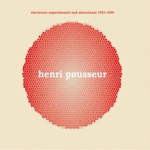|
|
 |
Dusted Reviews
Artist: Henri Pousseur Album: Electronic Experimental and Microtonal 1953-1999 Label: Sub Rosa Review date: Feb. 9, 2009 |

|
|
|
 |
A brief history of temperament and intonation: In the Western world over the past 200 years, temperament has largely been defined by the 12 equal divisions of an octave, as a system known as “equal temperament.” This scale itself is a compromise, devised in order to make the piano sound “good” in every key, but sacrificing the sound of the “perfect” fifth, the 3:2 frequency ratio between two pitches. Before that, though, temperament was a contentious issue, with different systems built on slightly different ratios and compromises, creating a situation where some keys sounded good and others very strange. When 17th and 18th century writers talk about how different keys have different moods and emotions, it’s not just because these writers had perfect pitch, but because some keys literally sounded sour. The 20th century saw renewed interest in the problems of temperament, with folks like Harry Partch, La Monte Young, Terry Riley, and György Ligeti exploring different ways of dividing the octave, and the sonic possibilities that arise from these unequal divisions. Partch even wrote a long, inscrutable tome (Genesis of a Music) in which he outlined the influences that led to his 43-note division of the octave. And in the non-Western world, intonation systems are just as varied and multivalent as the societies they come from.
Needless to say, a full history of temperament would fill multiple books, and get into fairly arcane mathematical processes that are fascinating but tell us very little about the music itself. This disc captures Belgian composer Henri Pousseur’s forays into microtonality, five works from throughout his compositional career. The rest of the disc’s title is a bit of a misnomer, since only one of the works involves electronics, and microtonal music is inherently experimental (not to mention that the word itself means so much, yet so little).
The disc begins with a 1953 composition called “Prospection” for three pianos tuned 1/6th of a tone apart, written at a time when Pousseur was close friends with Pierre Boulez (a friendship, like most of Boulez’s friendships, that would get strained over the years for various aesthetic reasons, Boulez being notoriously volatile in his aesthetic pronouncements). The piece follows all the strictures of the serialist dogma that was dominant at the time, with every pitch, dynamic, and articulation dictated by a mathematical row, and is in many ways a companion to Boulez’s “Structures I” for two pianos. Unlike the Boulez, which is essentially a wall of undifferentiated, uninteresting, unrelenting pitch density, the Pousseur sparkles with the subtle tuning differences between the pianos. When the pianos strike the same key, they create a pitch halo, sounding like the world’s most spectacularly out of tune piano. Thus what would be a bleak serialist façade falls to the background, its dissonances achieving an entirely new level of resonance, unleashing an otherwise impossible expressive force. “Figures enlacées" (1999) for organ feels almost like an afterthought in comparison, sounding like a mere exploration of the different possible sounds of the mean-tone organ (mean-tone being one of those 17th century temperament systems) it’s performed on. Messiaen did this sort of thing a whole lot better.
“Racine dix-neuvieme de huit-quarts” (1975) for cello solo and “Ex dei in machinam memoria” (1972) for oboe and electronics take microtonality in a somewhat different direction. By this point Pousseur had utterly abandoned serial techniques (hence the schism with Boulez), thus allowing him the freedom to explore other ways of conceiving harmony. The two works are similar in that they both begin with specific microtonal palates - “Racine” with a 19-tone scale, half way between equal temperament and Christian Huyghens’s 31-tone system; and “Ex dei” on the pitch content of an oboe piece by Stockhausen – and they both find inventive ways to tease out the possibilities of these systems. And those possibilities tend to be fairly melodic and consonant. In “Racine,” Pousseur picks notes that tend to sound almost tonal, with splatterings of dissonance and oddly tuned intervals thrown in to make the melodies that much more melodious. The piece seems to be built like a mobile, with different ideas returning at unexpected moments in new guises. In a way, it’s almost improvisational. “Ex dei,” on the other hand, is much darker, with the pinched tone of the oboe haunted by processed echoes of itself and ’50s sci-fi movie sounds. The music is also much more jagged and fragmentary.
The final work on the disc, “At moonlight, downland’s shadow passes along Ginkaku-Ji” (1983) for shakuhachi, koto, and shamisen, seems a little slight by comparison. Since it uses non-Western instruments, the piece is quite at home in its microtonality, and it effortlessly inhabits the Japanese sound space. But there’s something too easy about it; while I’m sure a listener familiar with Japanese musical style will find this piece an interesting recasting of tradition, to my ear the connotations of the instruments seem to outweigh the power of the notes. I hesitate to say that it’s too “exotic,” or to imply that only Western instruments can be “weighty,” but as a Western composer, one must be careful with how one uses non-Western instruments. All that said, it is an enjoyably complex and emotive work, perhaps even more than any of the other works here.
By Dan Ruccia
|







